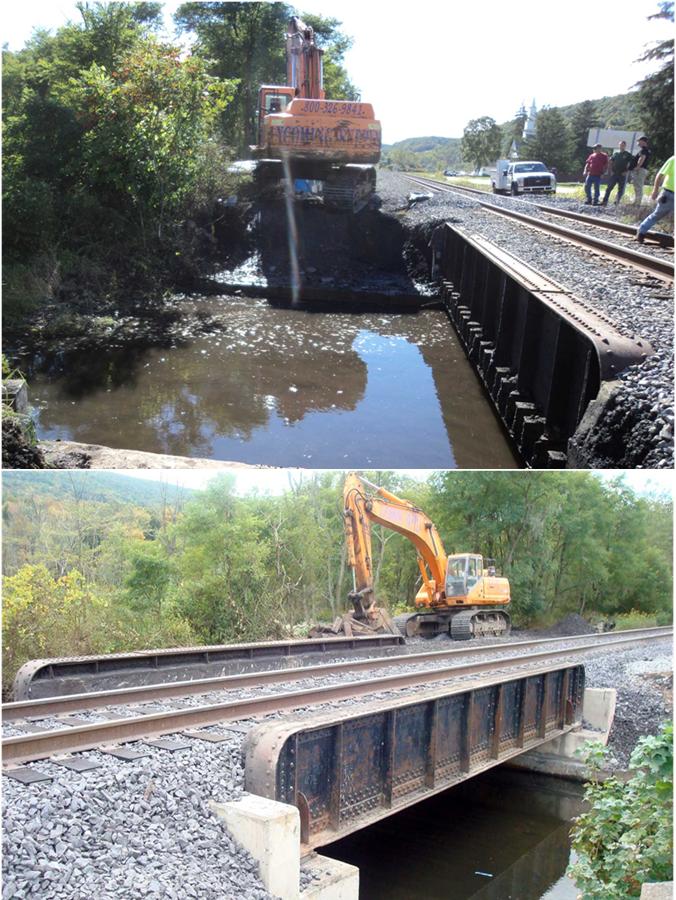This article is part of the series Regional Approaches to Resilience: A Tour of Resilience Work around the Country. The article was written by NADO Community and Economic Resilience Fellow Lexie Albe, with support from the Economic Development Administration.
The SEDA-Council of Governments (SEDA-COG) represents nearly 300 municipalities within 11 Central Pennsylvania counties. Most of the cities and towns in this predominately rural region were built along the Susquehanna River and its tributaries, leaving them particularly susceptible to devastating floods. In 2011, SEDA-COG had two federally declared major disasters within its region that inundated local towns and destroyed roads, bridges, and other critical infrastructure. With budgets already stretched thin and the threat of more frequent and intense storm events in the near future, SEDA-COG has undertaken a number of efforts to build resilience throughout their regional infrastructure networks.
As part of one such initiative, SEDA-COG is currently conducting an inventory of locally-owned structures that are too small to be included in the National Bridge Inspection program. Evaluations are underway in all of SEDA-COG’s 11 counties, with eight counties’ evaluations being overseen directly by the SEDA-COG Metropolitan Planning Organization (MPO). The remaining three counties belong to different MPOs, all of which are conducting similar assessments. Although there is not currently any dedicated funding to support small bridge removal or rehabilitation, the inventory is the first step in establishing whether the structures meet the criteria for at-risk bridge funds included in Pennsylvania’s Act 13. The inventory will be used to prioritize projects and help local bridge owners document conditions for using FEMA recovery funds after an event.

Another critical piece of the region’s infrastructure that is susceptible to disruptions and damage from floods is SEDA-COG’s extensive rail network. When it comes to ensuring the movement of goods, SEDA-COG is uniquely positioned for resilience building activities since the SEDA-COG Joint Rail Authority (JRA) owns five short line railroads within the region. Over the past several years, SEDA-COG JRA has been proactively incorporating design features into railroad bridge projects to remove the structure from any induced flooding and protect the bridge from future high mark events.
One such example is the recently completed $11.1 million replacement of the Loyalsock Creek railroad bridge, which was severely damaged by floodwaters from Tropical Storm Lee in 2011. SEDA-COG JRA provided $1.1 million for the project and pieced together additional funds from the Federal Railroad Administration’s Rail Line Relocation Grant Program, PennDOT’s Rail Transportation Assistance Program, Federal Highway Administration, Federal Emergency Management Agency, and Pennsylvania’s Emergency Management Agency. Completed in July of 2014, the bottom chord of the new Loyalsock Creek Bridge has been elevated 3 feet above the 100 year floodplain and was built using a center truss design to withstand future floodwaters at unprecedented levels.

SEDA-COG JRA is also incorporating resilience into general maintenance and rebuilding practices throughout their 200-mile network of short line railroads. After a flash flood in June of 2013 caused significant erosion along tracks in Clinton County, SEDA-COG JRA fortified the tracks with additional riprap and reopened decades-old transverse pipes to reduce erosion by allowing storm water to flow under the elevated tracks rather than over or along them. In neighboring Centre County, SEDA-COG JRA is proactively elevating stream crossings throughout their network to counter the increased sedimentation caused by the storm waters running off of the Allegheny Front. They are also working with local municipalities throughout the region to address drainage issues, decrease the hydrological impacts of structures, and implement erosion control practices along railway stream banks.
Although incorporating resilience measures may increase the short-term costs of projects for JRA, the Board of Directors has fully embraced a new approach that builds to a higher standard. When explaining the importance flood resilience initiatives, Jeff Stover, executive director of SEDA-COG JRA, provided one of many similar anecdotes from the region. In 2013, a thunderstorm in Clinton County dumped five inches of rain on the area and triggered flash flooding that resulted in $500,000 in damage to only three short miles of a JRA line. This is one of a growing number of examples why repeated damage demands restoration that has a better chance of mitigating risk and withstanding future flood damage. Stover added, “It is simply good business to improve and protect the infrastructure and not just replace as it was, and wait for the next storm.”
Key Strategies for Success:
Support your argument with numbers – when the ultimate decision rests with folks that are business-minded, you must be able to show the advantages of being proactive and spending a little bit extra up front.
Get creative and blend funding streams – as federal funding for infrastructure becomes more competitive, it is more important than ever to pursue multiple sources of funding for the same project.
Don’t underestimate the power of incremental changes through regular operations and maintenance – the large projects with big price tags get most of the glory, but significant progress can be made by taking a lot of seemingly small actions throughout an entire network.
This project is supported by EDA under Agreement Nos. 04-79-06700, 04-06-06694, and 01-79-14223. Any opinions, findings, or recommendations expressed in these case studies are those of the author and do not necessarily reflect the views of EDA or the NADO Research Foundation.
